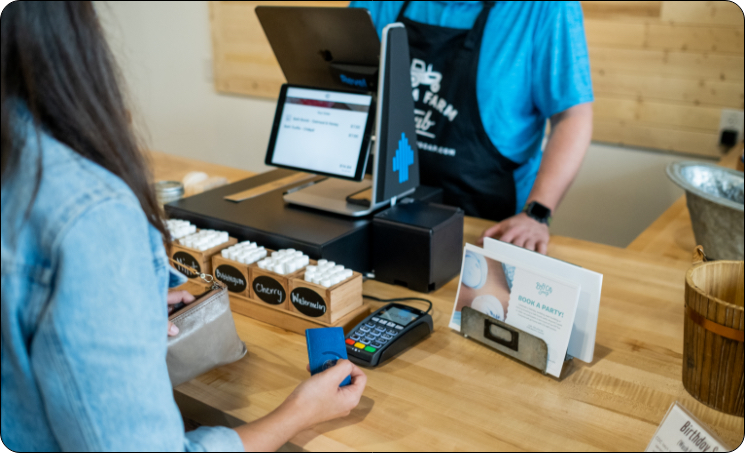Call Sales: +1 (833) 437-3835
Call Sales: +1 (833) 437-3835
Sydney Kida | April 29, 2022 |

Are you trying to decide on a pricing strategy for your products and services? Evaluating your costs and adding markup isn't enough to figure out how much to charge for your goods.
Determining your pricing, however, doesn’t have to be a sacrifice or a gamble. There are various pricing models and tactics that can help you better understand your audience and develop a strong strategy.
Today, we'll cover the ins and outs of creating a profitable pricing strategy for your business.
Pricing is one of the first factors that might influence a customer's decision to buy or not buy your product. As a result, it should be selected carefully.
A pricing strategy is a model or approach for determining the most appropriate price for a product or service. It assists you in selecting a price that optimizes profits and shareholder value while taking consumer and market demand into account.
Despite all of the different pricing strategies, a successful plan strengthens your position by instilling trust in your customers while still achieving your business objectives. And remember, your pricing model isn’t rigid – you can change it as necessary. Studies have shown that simple price changes may increase or decrease revenue by 20% to 50%.
Not convinced you need a pricing strategy yet? Here are a few additional reasons it’s essential for your business.
Price is hands-down king in terms of marketing mix flexibility; you can adjust it up or down almost infinitely. Compared to other factors like goods, location, or promotion, prices can be quickly modified to match the needs of the market and consumers.
To demonstrate, think about how much time it takes to implement changes in advertising or promotional operations. In contrast, pricing is exceptionally malleable and may be adjusted to suit the circumstances. Because of this flexibility, it is an essential part of marketing.
Low pricing may initially attract clients, but low prices aren’t always sustainable and raising prices later typically results in backlash from existing customers. As with a high price, a low sales volume means more profits. It is critical to set the proper pricing to maintain a healthy balance between profitability and sales volume.
For many customers, the price of a product is the first thing they notice. After knowing the pricing, customers will want to learn more about the product's features and benefits. To determine whether or not to purchase a product, the consumer will likely look at the price in relation to the product's perceived worth.
It's possible that a buyer won't be interested in learning more about a product if it's priced too low. They often feel that the low price reflects low quality. If they believe the cost is reasonable, they will trust the quality and be more likely to make a purchase.

If you’re running a sales promotion, a product's pricing strategy is the most essential factor since it is the most adaptable component of the marketing mix.
For example, you may temporarily lower the price of a product to boost sales. Even a slight drop in the price of a product whose demand is price sensitive might increase sales.
Sales promotions are a great way to attract new customers and keep existing customers happy. Check out these effective sales promotional ideas for inspiration.
Many aspects of your organization – such as revenue targets, business goals, key demographics, brand positioning, and product features – are taken into account when developing pricing plans. External factors such as customer demand, competitive price, and broader market and economic developments also have an impact.
It's not unusual for business owners and entrepreneurs to gloss over price. They frequently examine their product's cost of goods sold (COGS), compare it to their competitors, and adjust their selling price by a few bucks. While your costs of goods sold and rivals are essential, they shouldn't focus on your pricing strategy.
You will maximize your profit and sales if you choose the optimal pricing plan. Here are a few of the most popular pricing models examples to consider:
Competitive pricing focuses on a company's product or service's current market rate while ignoring the cost of the product or consumer demand. On the other hand, a competition-based pricing strategy uses the prices of rivals as a standard. This method may be appropriate for businesses that compete in a highly saturated market, where a slight price difference may be the determining factor for clients.
With structured price strategy marketing, you may price your items slightly lower than your competitors or marginally higher than your competitors. Regardless of the price you pick, competitive pricing is one method to remain ahead of the competition and keep your pricing dynamic.
As a small business owner, you're probably seeking new ways to break into the market and increase the visibility of your goods. Penetration pricing aims to recruit customers by offering goods and services at lower rates than rivals. Penetration pricing methods divert attention away from other companies, resulting in increased brand awareness and loyalty, leading to long-term contracts.
Penetration pricing can be dangerous because it might result in a loss of revenue for the company at first. On the other hand, increased awareness may promote earnings and help small companies stand out from the crowd over time.
After conquering a market, company owners might raise pricing to better represent the product's position within the market in the long run. One of the many competitive pricing methods accessible is penetration pricing.
Another option is dynamic pricing, which we'll discuss further below.
Cost-plus pricing is often referred to as markup pricing. Companies that use it "markup" their items according to how much profit they want to make. To use the cost-plus approach, double your product's production cost by a specified percentage.
Retailers who offer tangible products generally utilize cost-plus prices policies. However, it's worth noting that this isn't an ideal method for service-based businesses since their services typically provide more value than the cost of development.
Various organizations use economy pricing, including generic food providers and discount stores, to target the most price-conscious customers. This price strategy is a barebones approach that reduces marketing and production costs to the absolute minimum. Companies may establish a lower sales price yet make a profit since their expenditures are lower.
While economy pricing is highly beneficial to major corporations such as big box stores, it can be risky for smaller enterprises. Small businesses may find it difficult to minimize manufacturing expenses because they lack the sales volume of larger organizations.
Dynamic pricing is a pricing method in which prices are tailored to the market and consumer demands. Industries utilize algorithms that assess competition price, demand, and other variables. These algorithms allow enterprises to adjust rates based on when and how much a consumer is willing to pay when they're ready to buy.
This type of pricing might help you stay on track with your marketing strategy. Your team may plan promotions ahead of time and set up the pricing algorithm to launch the promotion price at the right moment.
Businesses utilize premium pricing to raise expenses because they have a one-of-a-kind product or service that no one else can match. If you have a significant competitive edge and know you can charge a higher price without being undercut by a product of comparable quality, you should consider utilizing this method.
However, customers must feel that things are worth the higher price tag. Thus, a company must work hard to generate a sense of value. Along with developing a high-quality product, business owners need to ensure that the packaging, decor, and marketing plan for the development all work together to justify the premium pricing.
Freemium pricing is when a business markets a "free," basic version of its product in the hopes that consumers will eventually pay to upgrade or gain access to more features.
As opposed to cost-plus, Freemium is a pricing structure often employed by SaaS and other software businesses. They select this technique because free trials and restricted memberships allow potential customers to sample a software's full capability while establishing trust before buying.
With freemium, a business's prices must be based on the perceived worth of its goods. Freemium pricing may not make your enterprise a lot of money at first, but it provides you access to the client, which is just as valuable.
You can nurture the consumer into a brand loyal advocate with a respectable LTV if you have access to their email inboxes, phone numbers, and any other contact information you obtain in return for the free goods.
Price skimming, designed to help businesses maximize revenue on new goods and services, entails setting prices high throughout the early stages of a product's life cycle. As new competitors enter the market, the company steadily cuts pricing.
Price skimming allows businesses to maximize earnings on early adopters before decreasing prices to attract more price-sensitive customers. When initially debuting a product on the market, price skimming helps a business recoup its development expenditures and gives the impression of quality and exclusivity.
A skimming pricing approach can be practical if you sell items with varied life cycle durations.
When a corporation uses a high-low pricing strategy, it offers a product at a high price at first, then reduces the cost when the product loses novelty or relevance.
Discounts, clearance areas, and year-end deals are all instances of high-low pricing in action, which is why it's also known as a discount pricing strategy. A high-low pricing plan can help you maintain consistent foot traffic in your businesses throughout the year.
By analyzing the popularity of your items at different times of the year, you can take advantage of reduced prices to boost sales during commonly sluggish months.
Psychological pricing aims to raise demand by giving the buyer the impression of increased value by inducing clients to respond to offers based on emotional rather than rational impulses. This pattern might be explained by people paying more attention to the first number on a price tag than the last.
Consultants, freelancers, contractors, and other workers that supply business services frequently employ hourly pricing, also known as rate-based pricing. Some clients are wary about honoring this pricing model since it may favor labor above efficiency. Hourly pricing is simply a time-for-money exchange.
Hourly pricing might be the perfect incentive for consumers to collaborate with you if your business thrives on short, high-volume jobs. If you break down your rates into hourly chunks, customers might choose to deal with you based on a cheap price point rather than finding a place in their budget for a costly project-based engagement.
A project-based pricing rate is the opposite of hourly pricing – instead of directly exchanging money for work, this method charges a fixed price per project. Consultants, freelancers, contractors, and other persons or employees providing business services utilize this method.
The value of the project deliverables may be used to estimate project-based pricing. Those that choose this pricing model can also generate a flat price based on the project's projected time.
Project-based pricing may be more enticing by emphasizing the benefits a client would receive from partnering with your company on a project. Despite the project's high cost, the one-time investment may be worthwhile. Your clients will know that they can work with you until the job is finished, not only until their allowed time is complete.
Small companies use bundle pricing to sell multiple items at a lower price than consumers would pay if they bought each item separately. This is effective because customers feel that they are getting better value for their money.
Bundling items can help you save inventory while also increasing the perceived value of your brand in the eyes of your customers. Many small businesses use this method near the end of a product's life cycle, mainly if the product is hard to sell. Small company owners should remember that the profits earned on higher-value goods must offset the losses incurred on lower-value ones. They should also think about how much money they'll save in overhead and storage space if they retire outdated items.
Small company owners should remember that the profits earned on higher-value goods must offset the losses incurred on lower-value ones. They should also think about how much money they'll save in overhead and storage space if they retire outdated items.
If you want to extend your company beyond state or international borders, you'll need to consider geographical pricing. However, this pricing method will need to include taxes, customs, transportation expenses, and location-specific rent are all factors that influence pricing variations.
Traditional supply and demand will also have a role in the regional price.
For this pricing strategy example, let’s say you're in the business of selling athletic gear. In your cold-climate retail outlets, you may charge a higher fee for winter clothing than you do in your warm-climate companies. This is because you know that people are more inclined to buy winter garments in colder regions, so you raise the price to capitalize on the demand.
Another competitive pricing method is promotional pricing. It entails providing discounts on a particular product. You may, for example, provide your clients vouchers or coupons that entitle them to a percentage off a product or service. You may also consider a "Buy One, Get One" (BOGO) promotion, with an additional product tacked on as a bonus.
Short-term promotional price campaigns are possible. For example, you might run a promotional pricing plan over a long weekend. Business owners may build buzz and enthusiasm about a product by giving these discounts as limited-time specials.
Customers are also enticed to act immediately by promotional prices before it's too late. The fear of missing out is used in this pricing technique.

Developing a strong and effective pricing strategy requires tracking several moving parts in constant flux. To start, you need to begin with your finances. Your financial data is one of the most critical aspects impacting your pricing approach.
First, you need to know how much it costs to manufacture or offer your services. You must regularly keep track of these costs to respond promptly to changes and sustain long-term profitability.
External factors are often just as crucial as your manufacturing costs. Understand your market, competitors, and consumers. Emerging trends, supply chain challenges, and even changing brand perceptions can all compel you to adjust your pricing approach quickly.
Finally, think about your long-term revenue objectives. If you're selling high-end items and want to increase demand, consider whether reductions will do more damage than good by lowering your product's perceived worth.
Here are some factors to consider when determining which strategy is right for you.
You want to develop a plan that is tailored to your specific business. First and foremost, you must assess your price potential. This is an estimate of the product or service pricing your company may attain based on cost, demand, and other factors.
You must price your goods based on the sort of customer persona that is interested in it. Interview customers and prospects to learn more about what they like and dislike and get feedback from your sales staff on the best leads and their attributes.
Beyond your primary segmentation and value metric, the monetization game is tactical and research-based. Discounting, add-ons and packaging techniques are all similar. To choose your pricing point, you must first investigate those sectors and then make selections in the field. The fact is that monetization is never complete since it is the core of turning your value into a framework appropriate for your target client groups.
Examine your prior pricing approaches. You may compare the number of closed transactions, churn statistics, and sold goods for various pricing strategies that your company has used and see which ones were the most effective.
You can't come up with a pricing plan without first researching what your rivals have to offer. When you observe a pricing discrepancy for the same goods or service, you'll have to choose between two options:
Conduct a complete competitive study to examine the competition's entire product or service offering and their strengths and shortcomings, and adjust your pricing approach appropriately.
Building an effective pricing strategy is complex and includes lots of moving parts: competition, production expenses, client demand, industry demands, profit margins, etc. Fortunately, you don't have to tackle all of these aspects at once. Sit down, analyze your metrics, and find out what's essential for your business. Begin with only what you need and you build out from there.
To help you keep operations running smoothly, make sure you have the right equipment to keep your business organized. Partner with Revel and invest in a comprehensive iPad POS system to easily access and organize your company data for informed decision making. Contact Revel Systems® today to learn more about how we can help streamline your business.